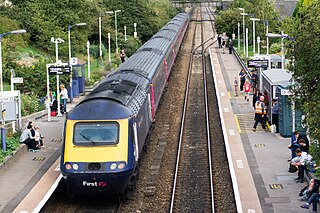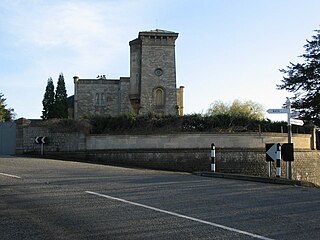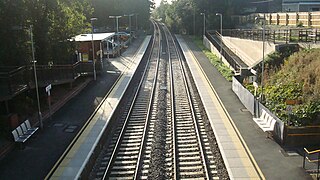
Bristol Temple Meads is the oldest and largest railway station in Bristol, England. It is located 118 miles 31 chains away from London Paddington. It is an important transport hub for public transport in the city; there are bus services to many parts of the city and surrounding districts, with a ferry to the city centre. Bristol's other major station, Bristol Parkway, is a more recent station on the northern outskirts of the conurbation. It is the busiest station in South West England.

Bath Spa railway station is the principal station serving the city of Bath in Somerset, England. It is on the Great Western Main Line, 106 miles 71 chains down the line from the zero point at London Paddington between Chippenham to the east and Oldfield Park to the west. It is the busiest station in Somerset, and the second busiest station in South West England after Bristol Temple Meads.

Oldfield Park railway station is on the Great Western Main Line in South West England, serving the mainly residential areas of southern Bath, Somerset. It is 107 miles 72 chains (173.6 km) down the line from London Paddington and is situated between Bath Spa and Keynsham.

Templecombe railway station serves the town of Templecombe in Somerset, England. It is situated on the West of England Main Line, 112 miles 2 chains (180.3 km) down the line from London Waterloo. The main station opened in 1860 but a smaller station on the lower line opened in 1862. It was closed in 1966 but was reopened in 1983 following local community pressure. It is currently operated by South Western Railway.

Kelston is a small village and civil parish in Somerset, 4 miles (6.4 km) north west of Bath, and 8 miles (12.9 km) east of Bristol, on the A431 road. It is situated just north of the River Avon, close to the Kelston and Saltford locks. The parish has a population of 248.

Keynsham railway station is on the Great Western Main Line in South West England, serving the town of Keynsham, Somerset. It is 113 miles 63 chains (183.1 km) down the line from London Paddington and is situated between Oldfield Park and Bristol Temple Meads stations.

Minehead railway station is situated in Minehead in Somerset, England. First opened in 1874 as the terminus and headquarters of the Minehead Railway, it was closed by British Rail early in 1971. It reopened in 1976 and is now the terminus and headquarters of the West Somerset Railway, a heritage railway.

Williton railway station in Williton, Somerset, England, was opened by the West Somerset Railway in 1862 and closed by British Rail in 1971. It was reopened in 1976 as a heritage line. The locomotive workshops here are the headquarters of the Diesel and Electric Preservation Group (DEPG).

Saltford is a large English village and civil parish in the Bath and North East Somerset unitary authority, Somerset. It lies between the cities of Bristol and Bath, and adjoins Keynsham on the same route. Saltford Manor House claims to be the oldest continuously occupied dwelling in England.

The Devon and Somerset Railway (D&SR) was a cross-country line that connected Barnstaple in Devon, England, to the network of the Bristol and Exeter Railway (B&ER) near Taunton. It was opened in stages between 1871 and 1873 and closed in 1966. It served a mostly rural area although it carried some through services from east of Taunton to the seaside resort of Ilfracombe.

Mangotsfield railway station was a railway station on the Midland Railway route between Bristol and Birmingham, 5 miles (8.0 km) north-east of Bristol Temple Meads and 82 miles (132 km) from Birmingham New Street, serving the village of Mangotsfield in South Gloucestershire, England. The station was opened in 1845 by the Bristol and Gloucester Railway, but had very little in the way of passenger amenities. The station was resited in 1869 to serve the new Mangotsfield and Bath Branch Line, and became an important junction station with extensive facilities and six platforms. Passenger footfall however failed to match the station's size, though at its peak eight staff were employed. The station closed in 1966 when services to Bath ended as part of the Beeching cuts, and the line through the station closed in 1969. The railway became a cycle path in the 1980s, and is a popular resting point on the route as several of the station's walls and platforms are still in situ.
There are 22 disused railway stations on the Bristol to Exeter line between Bristol Temple Meads and Exeter St Davids. The line was completed in 1844 at which time the temporary terminus at Beambridge was closed. The most recent closure was Tiverton Junction which was replaced by a new station} on a different site in 1986. 12 of the disused stations have structures that can still be seen from passing trains.

Flax Bourton railway station was a railway station on the Bristol to Exeter line, 5 miles 49 chains (9.03 km) from Bristol Temple Meads, serving the village of Flax Bourton in North Somerset. It opened in 1860, and was closed by the Beeching Axe in 1964.

Corston is a small village and civil parish close to the River Avon and situated on the A39 road in the Bath and North East Somerset unitary authority, Somerset, England. The parish has a population of 494.
The Mangotsfield and Bath branch line was a railway line opened by the Midland Railway Company in 1869 to connect Bath to its network at Mangotsfield, on its line between Bristol and Birmingham. It was usually referred to as "the Bath branch" of the Midland Railway.
Kelston was a small railway station about four miles west of Bath on the Midland Railway's Mangotsfield and Bath Branch Line.
The Langport and Castle Cary Railway is a railway line from Castle Cary railway station to Cogload Junction near Taunton, Somerset, England, which reduced the length of the journey from London to Penzance by 20+1⁄4 miles (32.6 km).

Pill railway station was a railway station on the Portishead Branch Line, 7.8 miles (12.6 km) west of Bristol Temple Meads, serving the village of Pill in North Somerset, England. The station was opened by the Bristol and Portishead Pier and Railway Company on 18 April 1867. It had two platforms, on either side of a passing loop, with a goods yard and signal box later additions. Services increased until the 1930s, at which point a half-hourly service operated. However the Portishead Branch was recommended for closure by the Beeching report, and the station was closed on 7 September 1964, although the line saw freight traffic until 1981. Regular freight trains through the station began to run again in 2002 when Royal Portbury Dock was connected to the rail network.

Chard Junction railway station was situated on the London and South Western Railway’s West of England Main Line about 1 mile (1.6 km) southeast of the village of Tatworth in Somerset, England. It was the junction of a short branch line to Chard. It was opened in 1860 as Chard Road, and closed in 1966. An adjacent milk depot was served by its own sidings from 1937 to 1980. Chard Junction signal box remained open to control Station Road level crossing and a passing loop on the long section of single track railway between Yeovil Junction and Pinhoe until March 2021, when control was passed to Basingstoke.

MetroWest, formerly known as the Greater Bristol Metro, is a project to improve the rail services in Bristol, England, and the surrounding region. It was first proposed at First Great Western's Stakeholder Event in March 2008. The aim of the project is to develop half-hourly services through central Bristol which will also serve the surrounding West of England region. Transport campaigning groups Friends of Suburban Bristol Railways (FoSBR) and Transport for Greater Bristol are actively supporting the proposal, as are the three unitary authorities under the West of England Combined Authority and North Somerset Council.
















